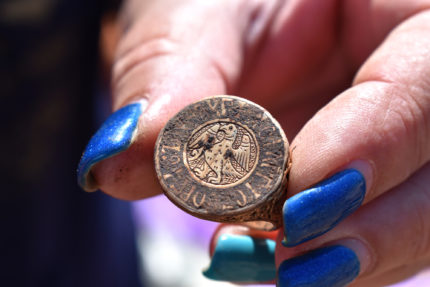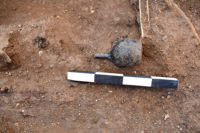 Bulgarian archaeologists have discovered the tomb of a 14th-century aristocrat from the Byzantine Palaiologos imperial dynasty at the Kaliakra Fortress in northern Bulgaria. The tomb’s occupant was identified by a gold signet ring inscribed with his name: Georgi Palaiologos.
Bulgarian archaeologists have discovered the tomb of a 14th-century aristocrat from the Byzantine Palaiologos imperial dynasty at the Kaliakra Fortress in northern Bulgaria. The tomb’s occupant was identified by a gold signet ring inscribed with his name: Georgi Palaiologos.
The ring is of the Kaloyan type, named after the gold seal ring found in a grave near the Church of the Holy Forty Martyrs in Tarnovo that was associated with the late 12th century Bulgarian Tsar Kaloyan but almost certainly belonged to a 14th century descendant with the same name. Georgi’s ring is much more impressive than Kaloyan’s, larger, heavier with more detailed engraving. The central image is a dove with a cross-hatched background. The inscription encircles it.
In 16 seasons of excavations, numerous burials of Kaliakran aristocracy have been unearthed at the fortress on the coast of the Black Sea. It was the capital of the Despotate of Dobruja in the 14th century, ruled by Balik, followed by his brother Dobrotitsa. They were allied to the Palaiologi. Balik supported Anna of Savoy, widow of Emperor Andronikos III Palaiologos and regent for her minor son John V Palaiologos during the Byzantine civil war (1341–1347). After Balik’s death in 1347, Anna carved out a larger autonomous province for Dobrotitsa to rule and he ended up conquering much of Bulgaria. Dobrotitsa’s daughter (we don’t know her name) married Michael Palaiologos, son of John V. It’s therefore eminently possible Georgi was related to both the despots and the emperors.
In the grave, the archeological team uncovered rich gifts that made it possible to restore the ritual of sending the young dead. The funeral was carried out in the second half of the fourteenth century, with a pit formed on a rock with a stone enclosure. The nobleman was laid in a coffin with well-preserved traces. His face was covered with luxurious fabric, gifts and a glass vessel were placed on his body, in which, according to his beliefs, the tears of the mourners were collected.
 Note to self: add a mourners’ tears goblet codicil to my will.
Note to self: add a mourners’ tears goblet codicil to my will.
This year’s dig will conclude at the end of the month. Later this year the National History Museum in Sofia will publish the full catalogue of finds from 2018’s star discovery, the clay pot full of coins, jewelry and other valuables dubbed the “Tartar booty.”